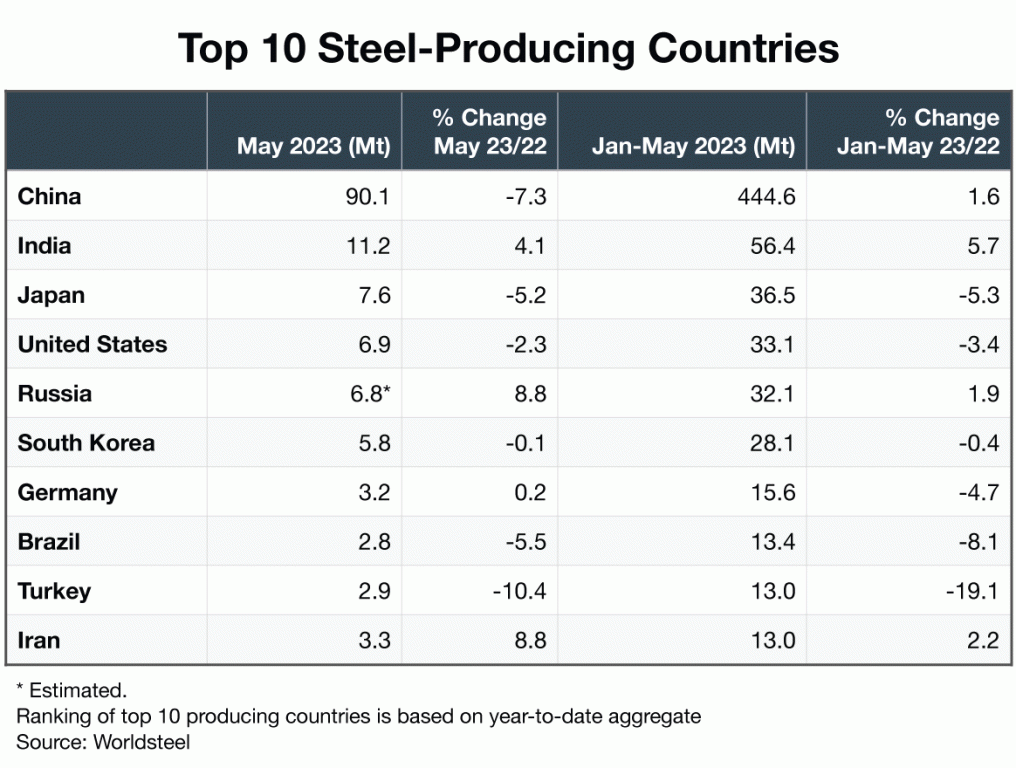Piles of debt, shrinking real estate and construction sectors spell trouble for production and demand.
Last year, the Chinese government’s abrupt end to its zero-COVID policy was welcomed as a harbinger of a return to economic growth. And, in fact, the reopening of the Chinese economy did stimulate a growth spurt.
But that didn’t last long. China’s growth has since stalled, and the thinking among some economists is that China’s zero-COVID policy has done long-term damage to the country’s growth prospects. Those prospects are reflected in China’s steel industry production and demand numbers—and in the prospects for their recovery.
Of course, one policy cannot take all the blame. China’s economy is subject to global trends that have inflicted economic woes elsewhere, including supply-chain congestion and inflation. The country also has its unique set of domestic challenges, including a falling population, mountains of debt, an ailing housing sector, and consumers who are reluctant to spend.
A government economic stimulus package encouraging consumer spending has been anticipated for some time but has yet to materialize meaningfully. Instead, the government continues to rely on stimulus in the form of investments—which may not do the trick. Ultimately, it’s the very nature of China’s economic and political systems that may prevent a significant recovery going forward.

Post-COVID Rise, Fall and Rise?
The post-COVID spike in China’s economic numbers is reflected in its levels of steel production. In March, China produced 95.7 metric tons of crude steel, up 6.9% from March 2022, according to the World Steel Association (Worldsteel), representing the end of China’s post-COVID growth surge. In April, China’s steel production was down 1.5% year over year and in May, it was down 7.3%.
Worldsteel’s most recent short-range outlook shows that global steel demand will rebound by 2.3% and will grow 1.7% in 2024, but China is not part of the picture. “In 2024, demand growth is driven by regions outside China,” said Máximo Vedoya, CEO of Ternium, and chair of the Worldsteel economics committee. After declining by 3.5% in 2022, China’s total steel demand is expected to grow by 2.0% in 2023 and to stay flat in 2024, he added.
China’s real estate and housing sectors—which represent 25% of the country’s GDP—continue to experience negative momentum, accounting for the sluggish steel demand. In 2022, the floor space of new projects dropped by 39.4% and investments in real estate declined by 10%, the first such decline in 25 years. “These acute declines will put pressure on construction activities in 2023 and 2024,” said Vedoya.
Infrastructure investments picked up last year thanks to government support, “but this was largely focused on less steel-intensive areas such as water supply systems, telecommunications, and logistics,” said Vedoya, and the same prospects are likely for this year and next.
Revitalizing the Economy
Beijing has taken some steps to revitalize economic growth. Small businesses received tax breaks and interest rates on bank deposits were reduced to encourage consumers to spend more and save less.
But these measures have proven ineffective as consumers continue to hoard cash and private investments decline. This has given rise to fears of a balance-sheet recession, “driven by high levels of private-sector debt rather than fluctuations in the business cycle,” according to a report from BNY Mellon. During a balance-sheet recession “debt repayment is prioritized above spending and investment, which ultimately leads to slower growth.”
The large housing and construction sectors remain at the heart of the problem. “Many developers remain excessively leveraged and have businesses based on outdated growth models,” said the BNY Mellon report. “Given these factors, it is perhaps unsurprising that sentiment in the real estate sector is at the lowest level in decades.”
Local governments and corporations in China have accumulated large volumes of debt, often collateralized by real estate and land that have experienced price declines. “The high level of debt within the economy is likely to become a headwind for growth in the years ahead,” said the report, “with ever greater amounts of new debt needed to generate each unit of incremental growth.”
Chinese officials have spoken about exporting their way out of trouble, but here, too, they face challenges. Exports have been flat this year and declined in May—by 18.2% to the United States—notable because Beijing has allowed the renminbi to decline by 7% against the dollar this year, which should have made Chinese exports more competitive.
First Year of 12
Late last year, the Chinese government announced a 12-year plan to expand household consumption to drive the economy, which was met with praise from some economists. China’s household spending represents 38% of GDP, well below the global average of 68%.
But, according to a report published by the Council on Foreign Relations, “Sensible though it is, consumption-led growth in Xi’s China is doomed to fail.”
One reason is that it will meet with pushback from constituencies that President Xi Jinping must satisfy, including state-owned enterprises, local governments, and the national security bureaucracy. Chinese consumers, for their part, “will be reluctant to embrace it,” said the report, “knowing that the leader will bury the initiative at the first signs of worry from the party. Instead, they will hunker down, saving yet more of their meager earnings for the expected hard times ahead.
“Xi,” the report concluded, “will never allow a consumer-led economy to take hold on the mainland.” Such an economy requires individual autonomy and free markets to respond to consumer demand, which the Chinese Communist Party under Xi “has been increasingly unwilling to accommodate.”
A consumer-centric stimulus package is likely the better alternative to steer China toward economic recovery, than government construction projects that will generate more debt. But a combination of structural and policy impediments and wary consumers may prevent that from happening. That all spells trouble ahead for the Chinese economy and its housing sector—as well as for steel industry demand and production.




